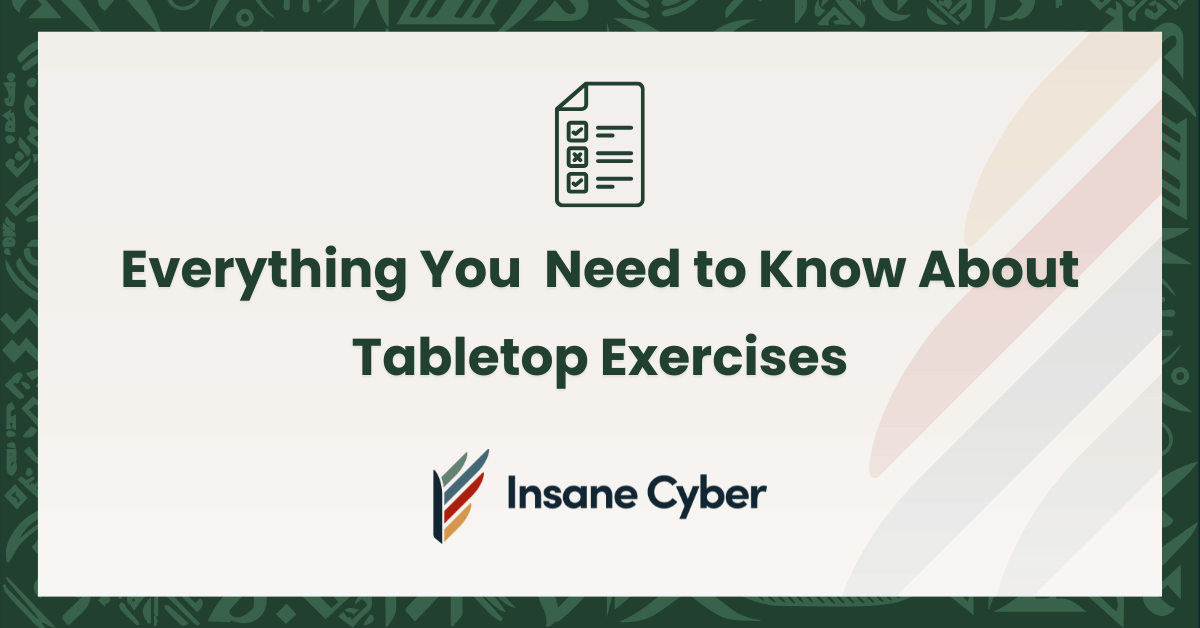With the constant advancements in industrial cybersecurity, preparedness isn’t optional—it’s essential. That’s where Operational Technology (OT) Tabletop Exercises come in.
Think of them as your organization’s emergency drills for cyberattacks. While no one hopes for a security breach, knowing exactly how your team would respond can make all the difference when seconds count.
What Are OT Tabletop Exercises?
OT tabletop exercises (often called TTXs) are structured simulations where key personnel gather to walk through hypothetical cyber incidents.
Instead of reacting in real time, they engage in guided discussions to test their response plans, evaluate decision-making, and identify any blind spots.
These exercises are particularly valuable in industrial environments, where OT systems control critical infrastructure—from manufacturing lines to power grids. When threats hit these systems, consequences aren’t just digital—they can be physical and costly.
Why These Exercises Matter
Beyond simply testing policies, TTXs reveal how well your people, processes, and technologies work together under pressure. They’re not about placing blame or identifying weaknesses for punishment—they’re about growth.
Here’s what a well-run tabletop exercise can achieve:
-
Promotes a Cyber-Aware Culture: It encourages proactive thinking across all levels of the organization.
-
Strengthens Team Coordination: Exercises highlight how departments can (and must) work together.
-
Enhances Decision-Making: With everyone aligned on their roles, responses become quicker and more effective.
-
Reduces Real-World Risks: Practicing real scenarios sharpens instincts, making actual responses smoother and more impactful.
Much like a dress rehearsal for a stage production, these exercises give your team the chance to refine their performance before the curtain rises on a real crisis.
The Three Types of OT Tabletop Exercises
Organizations can tailor tabletop simulations based on team roles and objectives. Here are the primary formats:
1. Operational & Technical Focus
Ideal for IT and OT frontline teams, this type of exercise evaluates:
-
Incident Response Plans (IRP)
-
Emergency protocols
-
Detection and mitigation capabilities
2. Crisis Management Simulations
These sessions involve a broader cast of players—from incident responders to plant managers—and test:
-
Business continuity under pressure
-
Crisis Management Plans (CMP)
-
Internal communication strategies
3. Executive-Level Scenarios
When cyber threats escalate to the boardroom, leadership must be ready. These exercises help senior executives:
-
Navigate strategic decisions during major cyber events
-
Align with governance standards (e.g., SEC cybersecurity disclosure rules)
-
Coordinate with legal, PR, and compliance teams
Building a Successful Tabletop Exercise
Running a tabletop exercise involves more than just gathering people in a room. It requires planning, execution, and thoughtful follow-up. Here’s how the process typically unfolds:
1. Planning and Preparation
-
Define your objectives and scope
-
Identify the right participants
-
Review relevant policies and response plans
2. Scenario Development
-
Create realistic, plausible incidents that stretch your team’s capabilities
3. Exercise Execution
-
Use expert facilitators to guide discussion
-
Encourage open collaboration and engagement
-
Simulate responses to unfolding threats using structured “injects”
4. Roles That Drive Success
-
Facilitators lead the discussion, ask probing questions, and ensure focus
-
Observers document interactions and note communication gaps
-
Data Collectors capture detailed responses and decisions for analysis
5. After-Action Review & Improvement Plan
-
Deliver a detailed report (After-Action Report or AAR) summarizing key insights
-
Use feedback forms to assess what worked and what needs improvement
-
Develop an Improvement Plan with clear action items and accountability
Frequency: How Often Should You Run TTXs?
Annual exercises are a good starting point, but quarterly sessions are recommended for organizations facing high cyber risk or undergoing significant change. Regular practice helps:
-
Keep skills sharp
-
Onboard new staff effectively
-
Adjust strategies based on evolving threats
10 Tips to Maximize Tabletop Impact
To make your exercise meaningful, consider these best practices:
-
Always Reference Your Response Plans
-
Include All Relevant Stakeholders – IT, OT, leadership, legal, and sometimes external agencies
-
Foster a No-Fault Environment – Encourage learning, not blame
-
Make It Real – Use scenarios relevant to your threat landscape
-
Encourage Participation – Every voice matters in a crisis
-
Maintain Plausibility – Keep it challenging but realistic
-
Use a Skilled Facilitator – They’ll push the team in the right way
-
Give It Time – Allocate 2-3 hours minimum, with multiple scenario injects
-
Focus on Process – Don’t just “win” the scenario; learn from it
-
Bridge Gaps Across Teams – TTXs should improve interdepartmental collaboration
The Bigger Picture: Why This Matters Now More Than Ever
Cyber threats aren’t slowing down—they’re getting bolder. Attacks are no longer just digital annoyances; they’re capable of shutting down operations, draining finances, and damaging reputations.
Consider these realities:
-
Business Email Compromise scams have skyrocketed by 1,300% since 2015
-
Cybercrime now costs the global economy $600 billion+ annually
-
60% of small and midsize businesses that suffer a major cyberattack don’t recover
Even tech leaders like Warren Buffett and IBM’s Ginni Rometty have called cybercrime a defining threat of our time.
Conclusion: Be Proactive, Not Reactive
Tabletop exercises aren’t just cybersecurity “nice-to-haves”—they’re essential tools in preparing your team for when—not if—a threat arises. They foster awareness, sharpen readiness, and ultimately safeguard your organization’s most critical systems and data.
Ready to put your cyber response to the test?
Make tabletop exercises a key part of your strategy—and strengthen your defense before the next attack begins.
Contact Insane Cyber to design a customized OT Tabletop Exercise that meets your organization’s unique needs.





